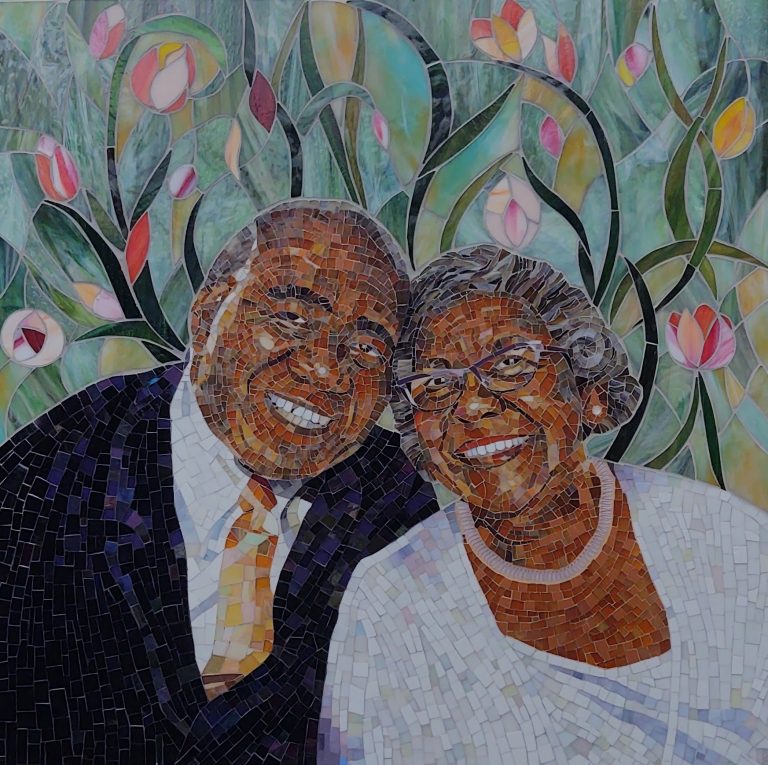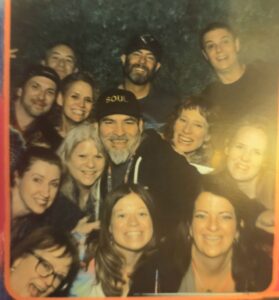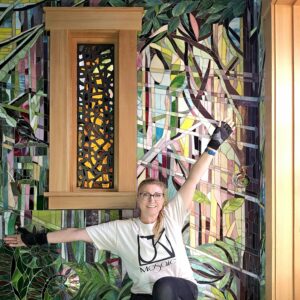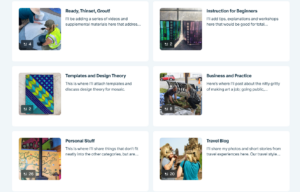Back in December, I announced that I had been selected to receive a grant from the Jordan Schnitzer Museum of Art. Sixty regional artists were chosen to create new work for exhibitions at three gallery locations to commemorate the Black Lives Matter movement, to take place later this year. I was selected based on some past work highlighting figures of color and my proposal, which was to create a large portrait of local icons Nat and Thelma Jackson. The couple, now in their 70s, have spent their lives working for racial equity and social justice, and continue to educate and advocate. When I learned about the Jacksons, I felt called to bring attention to their contributions by representing them in mosaic, but I have a loftier goal of installing the portrait as public art in Thurston County, where they live and work.
After being selected, I connected with the Jacksons to explain my proposal, get permission to use their image, get a sense of their personalities, and source photographs. They gave me a recent photo from their 50th anniversary. They both love gardening, plants and flowers, so I knew I wanted to create a botanical background, which would also signify growth, abundance and fruition. The couple has cultivated plants, equity, awareness, community and economic development, so it seemed fitting to represent a lush garden rising up behind them in the image.
I began working on this portrait in January 2021, though I wasn’t able to focus solidly on it due to a busy schedule of installations and commissions through spring. I set up a work station in my family room, and I usually worked on this after dinner with family nearby as often as I could manage. Portraits are challenging, and I really wanted to get this right, so the initial phase was painstakingly slow.
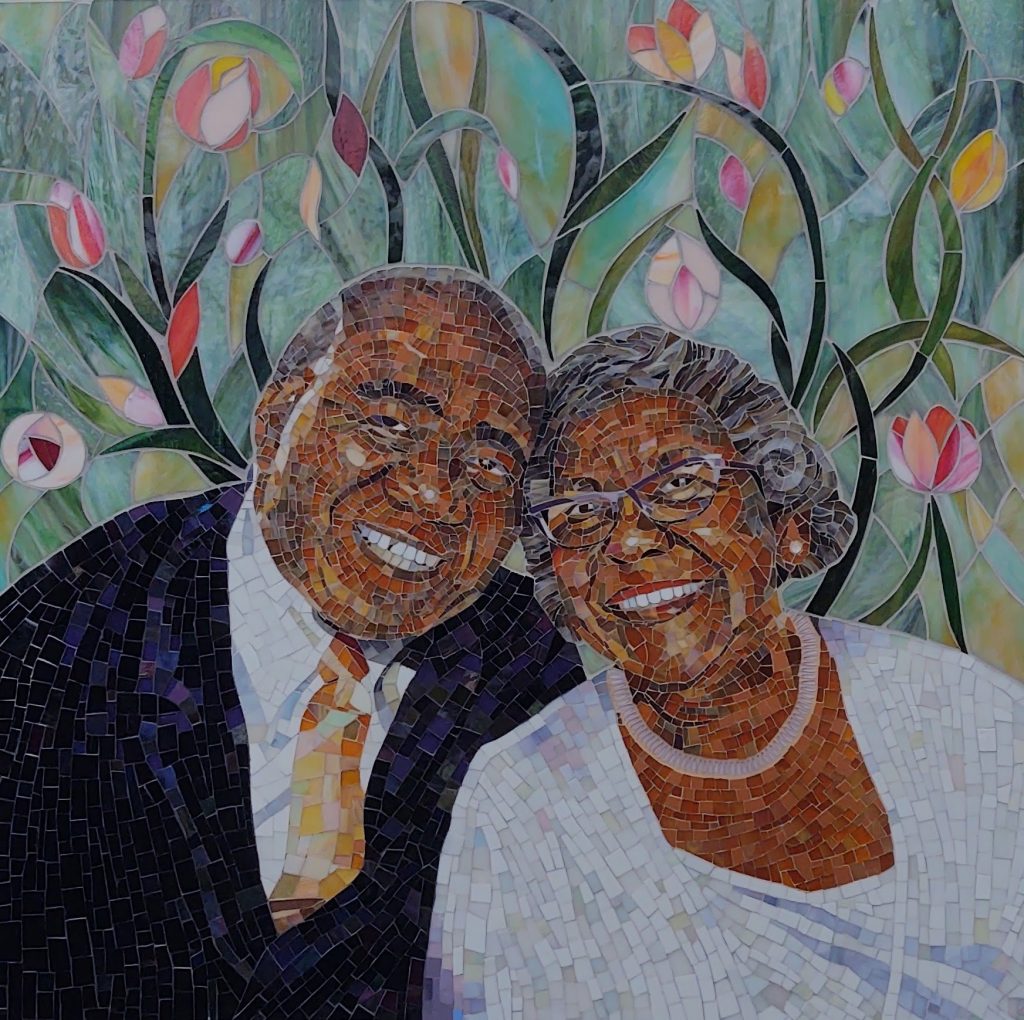
Finally, by early May, their faces were done, and I shifted to the clothing, which is far less detailed. And with a week to spare, I addressed the background, choosing wispy, sweeping shapes with a soft palette so it would recede, allowing the figures to come forward without overpowering or competing. The background design was also strategic because I am quite fast with precision cutting, and I had a deadline. While the portrait isn’t due for delivery at the gallery until late July, I have major family commitments in June and will be unavailable for studio work until mid-July. It will be getting a temporary frame for the exhibition during that time.
In the meantime, I’ve been working with the City of Lacey to identify a location for a final installation in 2022, after the Black Lives Matter exhibition ends. I’ve been applying for grants to support expansion of the panel into a mural, possibly with a community engagement component, but at this point, that’s just an ambition. The portrait is 3′ x 3′ and will stand on its own as a tribute to the lives and work of this power-duo. I encourage you to google them to learn more about their story.
Personal notes: This project has launched me on a broader exploration of local African American history. In college, I focused on culture, and spent a year on Native American studies, so I learned a lot about local history in that context. In the 34 years I’ve been a resident of WA, I was oblivious to Black history in this region. I assumed that the area was so predominately white simply because slavery was concentrated in the south and this area was largely undeveloped at that time. This is partly true. But my mind was blown when, several years ago, I learned that, after the Emancipation Proclamation, Oregon made a law that Black people were no longer allowed to reside there. They had to get out, fast, and if they did not, they were considered to have self-selected to remain a slave. With no place to go, their choice was to flee with what they could carry into the unknown, or remain slaves. Later in the 1900s, the trade industry flourished in Portland, and low-wage workers were needed. Many non-white folks moved there for work, but were not allowed to live in Portland. A makeshift city grew up along the border with Washington, called VanPort, then the second-largest city in Oregon. Living quarters were poorly constructed in a flood zone, and in 1948, the entire city was washed away in a flood. Some of the residents are still alive, by the way, and a project to document their stories can be found here: https://www.vanportmosaic.org/
When I learned this story, it was clear to me that the racial history of the Pacific NW is more complicated than I realized, and that I was profoundly uninformed. While working on this mosaic project, I’ve participated in lectures, panel discussions and watched recorded interviews to gain a better understanding of the Black history of Washington State. I cannot believe it took this long to learn, for instance, that this state was settled by a group of families led by a mixed-race African American man. George Washington Bush led a caravan across the country to OR to take advantage of the “free” land being made available (Native land) to settlers. It was an arduous journey and, by all accounts, it was his tracking and navigating abilities that made the expedition successful. They arrived in OR only to discover that Mr. Bush was in grave danger. The five families were committed to him, protected him, and they all chose to continue north, into uncharted territory, finally settling in Tumwater. Fellow Washingtonians, did you know that? If not, why not?
Right now, I’m processing and learning, and I hope I can find a way to develop the information into art that helps to educate local residents.

